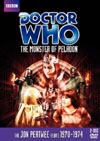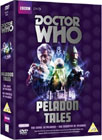DVD Extras include:
Silence in the CitadelA bizarre coding error in many satellite receivers in our area, and the fact that our satellite dealer was away for a two week hunting season, meant that for many years the only copies I had of this story and "Planet of the Spiders" (the next story) came to me completely silent. To keep myself interested in viewing the visuals, I dubbed all kinds of music onto that silence, whatever I could think of that had something to do with the mood of the scenes or sequences at hand. "Monster of Peladon" had a royal court nature earning it a lot of classical music, while "Planet of the Spiders" leant more towards instrumental pop songs of the 60's and 70's, especially those following the James Bond action spy trend. Subsequently hearing Dudley Simpson's scores, they do fall quite a fair bit short of my vivid auditory imagination.Again, I do question Simpson's choice to attempt to compose "new" music for every scene, instead of taking an approach of composing less, but in a thematic style, and reusing it across a wider range of stories. His actual music ends up sounding like it's stumbling randomly over the same territory again and again, without any really solid thematic material to help tie the emotional threads of the story together. Extra attentive listening reveals an attempt at a unique Peladonian anthem during early court scenes, and the percussion motif for the Ice Warriors from "The Curse of Peladon" (story no. 61), which sounds quite like one of Jerry Goldsmith's for Star Treks five and eight, makes a slightly modified return in this story, now embellished with a particularly excellent "ice-wind" instrument effect. Why is the impact of these wonderful bits so diminished? The answer seems to lie in the brass section, which is overused in most of Simpson's scores as it tries to follow every minutia of suspense, surprise, and disappointment in the visual drama with perfect synchronization, usually doing little for the emotional subtext of a story. One becomes too accustomed to the constant presence of this ambling brass and tunes the music out. The brass accompaniment during the Peladon Anthem in particular seems to be playing a three note motif that appears monotonously typical of most of Simpson's scores. Meanwhile the unique instrumentation of the new Ice Warrior stuff seems far too subdued in the final mix. A pity. There is some good composition here after all, but one has to dig to find it.
Plot ScrutinyThe main characters of this story generally get good entrances, with the etiquette of the royal court demanding a few proper introductions on top of a good exposition of tensions between the miners and the pro-technology hierarchy ruling Peladon. The Doctor and Sarah also make a suitable entrance with the TARDIS. Although the interior is not shown, it isn't terribly necessary today. Hayles quickly and expertly uses the typical mistrust by the locals to impart through dialogue everything one needs to know about our hero and his previous relationship to the planet. Before the episode is finished, the Doctor is investigating the heart of the sci-fi mystery plaguing the Peladonians, namely the supernatural and deadly manifestations of the beast Aggedor.Episode two's plot direction appears rather contrived. The Doctor and Gebek leave Ettis and the rest of miners to go to the citadel to talk to the Queen, but end up spending so much time wandering aimlessly in the tunnels that Ettis has time to convince the rest of the miners to violence, get to the citadel way ahead of the Doctor and Gebek, and raid the armoury. All this ensures that the Doctor actually will look bad when he eventually shows up at the citadel, so he can go through an ordeal in the pit of the real Aggedor. Not too believable. Oh well. Episode three has the Doctor's mandatory prisoner routine for this story, which also manages to come off like a bit of padding. Thankfully, it's a short-lived section of the episode. Jon Pertwee pulls a few worthwhile funny faces behind the bars, giving the sequence a bit of much needed entertainment value.
Sadly, we have to make do with watching flash charges go off on the many occasions when advanced weapons are fired, instead of having decent visual beam effects superimposed on the picture, and it doesn't look like the DVD CGI team is stepping up to this golden opportunity for improvement as it should. Oh well. At least the original show has a good energy during all its firefights, as flash charges allow the actors and cameras a lot of freedom of movement compared to older superimposition techniques. Sonic weapons are seen to have a more traditional mirrorlon implosion effect. While it gets pulled off much better here than in "The Seeds of Death" (story no. 48), it's still not quite as consistently good as it was back in "The Ice Warriors" (story no. 39).
The Best EpisodeEpisode Four is one of the best of the story. All the major characters and themes are in play, and the plot becomes complex yet elegant. When fighting Daleks, you crash your ship and reach for a good bomb. When fighting Cybermen, you make coffee. When fighting Ice Warriors, you crank up the heat, as the Doctor remembers to do in this episode along with everything else. It's probably the Doctor's busiest episode in the story. Gebek gets to make a really fun speech to help things out, and the Ettis problem comes to a good climax. The Doctor's fight at the end features a bit too much stunt double and not enough intercutting with footage of Pertwee himself for my tastes, but otherwise works fairly well. You can see how truly talented Terry Walsh is at hiding his features during any amount of flopping and falling about and making it seem believably in character.
Casting HighlightsI like Rex Robinson a lot in this one; I think it's my favourite of his Doctor Who performances. Donald Gee manages to remind me of Tom Baker a lot in his mannerisms. Nina Thomas can be very expressive and subtle, managing to make the Queen compelling and watchable even though the character is such a weenie on paper. Jon Pertwee and Elisabeth Sladen put in their usual exemplary work. Stuart Fell deserves mention for giving Alpha Centauri some very emotional gestures under difficult circumstances.Last of all, I have to ask, did anyone else notice that Max Faulkner's miner dies twice in the final episode? First, he and a friend get imploded in sonic blasts from the Ice Warriors, after which he comes around a corner to confront Eckersley and ends up getting shot by a Federation pistol. Topping that off, he's STILL alive afterward, in the background as Jon Pertwee says, "I think I know a way we can track him down", leaving the room and ending the scene.
A short list of Brian Hayles Stories, ranked from best to worst:
-The Curse of Peladon
-The Monster of Peladon
-The Ice Warriors (story no. 39)
-The Smugglers (story no. 28)
-The Seeds of Death (story no. 48)
("The Celestial Toymaker" (story no. 24) that ended up in Doctor Who
is too much of a Gerry Davis work to be included. I would need to see
the original Brian Hayles/Donald Tosh version of the script to rank it here.)
International Titles:Deutsch: (Das Monster von Peladon)Magyar: "A Peladon szörnye"Français: (Le Monstre de Peladon)Русский: "Монстр Пеладона"This story has become available on DVD and VHS video. Click on the Amazon symbol for the location nearest you for pricing and availability:
Comments on this article are welcome. You may contact the author from this page:
|








